stop start MITSUBISHI SHOGUN 2003 Owner's Manual (in English)
[x] Cancel search | Manufacturer: MITSUBISHI, Model Year: 2003, Model line: SHOGUN, Model: MITSUBISHI SHOGUN 2003Pages: 392, PDF Size: 14.34 MB
Page 43 of 392
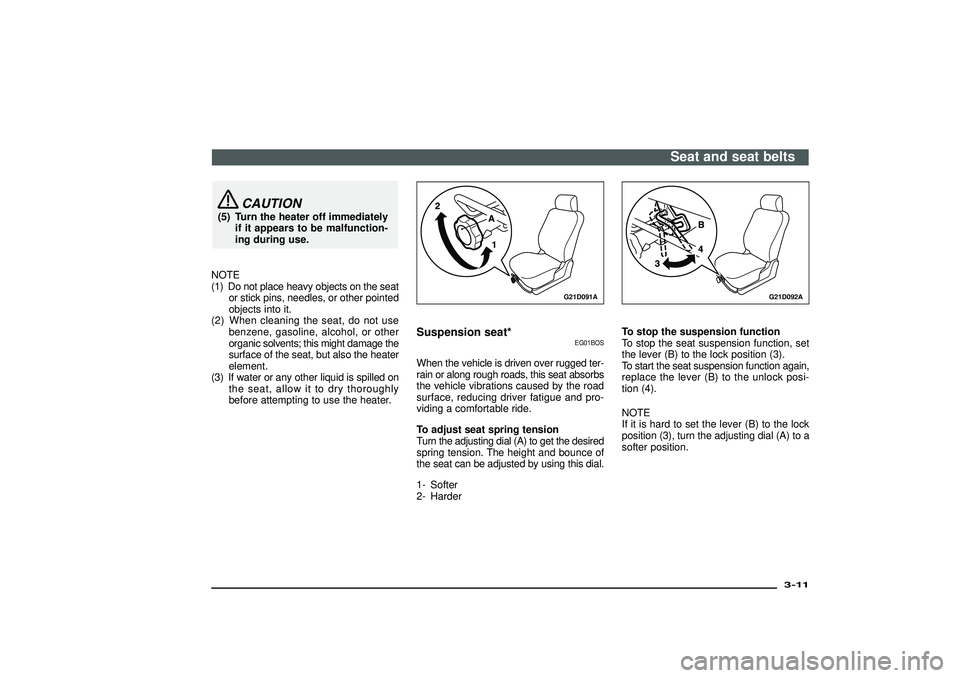
CAUTION
(5) Turn the heater off immediately
if it appears to be malfunction-
ing during use.
NOTE
(1) Do not place heavy objects on the seat
or stick pins, needles, or other pointed
objects into it.
(2) When cleaning the seat, do not use
benzene, gasoline, alcohol, or other
organic solvents; this might damage the
surface of the seat, but also the heater
element.
(3) If water or any other liquid is spilled on
the seat, allow it to dry thoroughly
before attempting to use the heater.
G21D091A
Suspension seat*
EG01BOS
When the vehicle is driven over rugged ter-
rain or along rough roads, this seat absorbs
the vehicle vibrations caused by the road
surface, reducing driver fatigue and pro-
viding a comfortable ride.
To adjust seat spring tension
Turn the adjusting dial (A) to get the desired
spring tension. The height and bounce of
the seat can be adjusted by using this dial.
1- Softer
2- Harder
G21D092A
To stop the suspension function
To stop the seat suspension function, set
the lever (B) to the lock position (3).
To start the seat suspension function again,
replace the lever (B) to the unlock posi-
tion (4).
NOTE
If it is hard to set the lever (B) to the lock
position (3), turn the adjusting dial (A) to a
softer position.
Seat and seat belts
3-11
Div:
Out put date:
Page 101 of 392
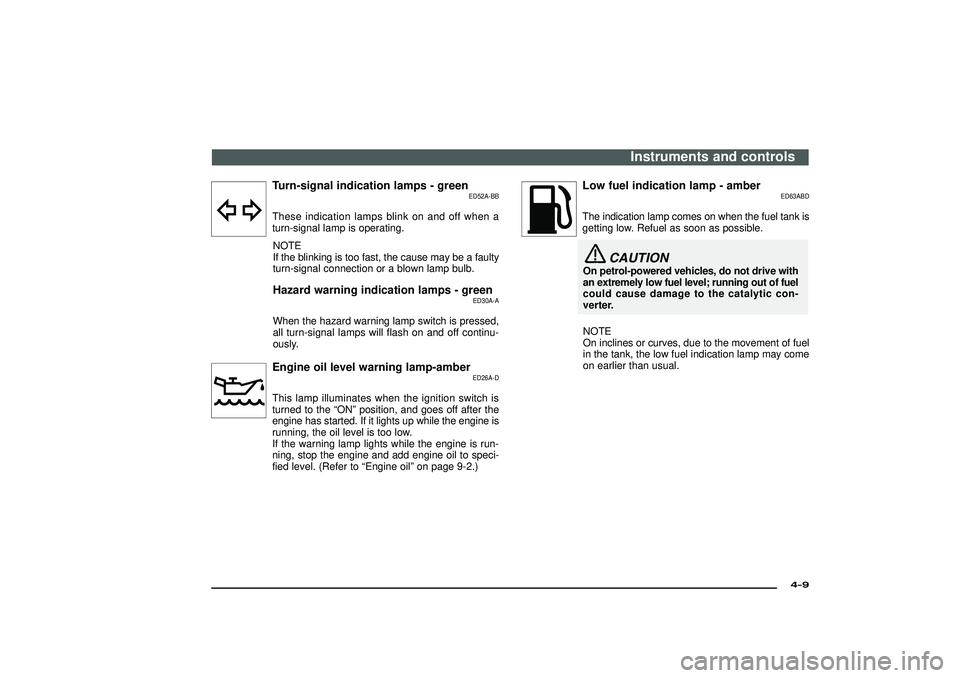
Turn-signal indication lamps - green
ED52A-BB
These indication lamps blink on and off when a
turn-signal lamp is operating.NOTE
If the blinking is too fast, the cause may be a faulty
turn-signal connection or a blown lamp bulb.Hazard warning indication lamps - green
ED30A-A
When the hazard warning lamp switch is pressed,
all turn-signal lamps will flash on and off continu-
ously.Engine oil level warning lamp-amber
ED26A-D
This lamp illuminates when the ignition switch is
turned to the “ON” position, and goes off after theengine has started. If it lights up while the engine is
running, the oil level is too low.
If the warning lamp lights while the engine is run-
ning, stop the engine and add engine oil to speci-
fied level. (Refer to “Engine oil” on page 9-2.)
Low fuel indication lamp - amber
ED63ABD
The indication lamp comes on when the fuel tank is
getting low. Refuel as soon as possible.
CAUTION
On petrol-powered vehicles, do not drive with
an extremely low fuel level; running out of fuel
could cause damage to the catalytic con-
verter.
NOTE
On inclines or curves, due to the movement of fuel
in the tank, the low fuel indication lamp may come
on earlier than usual.
Instruments and controls
4-9
Div:
Out put date:
Page 153 of 392
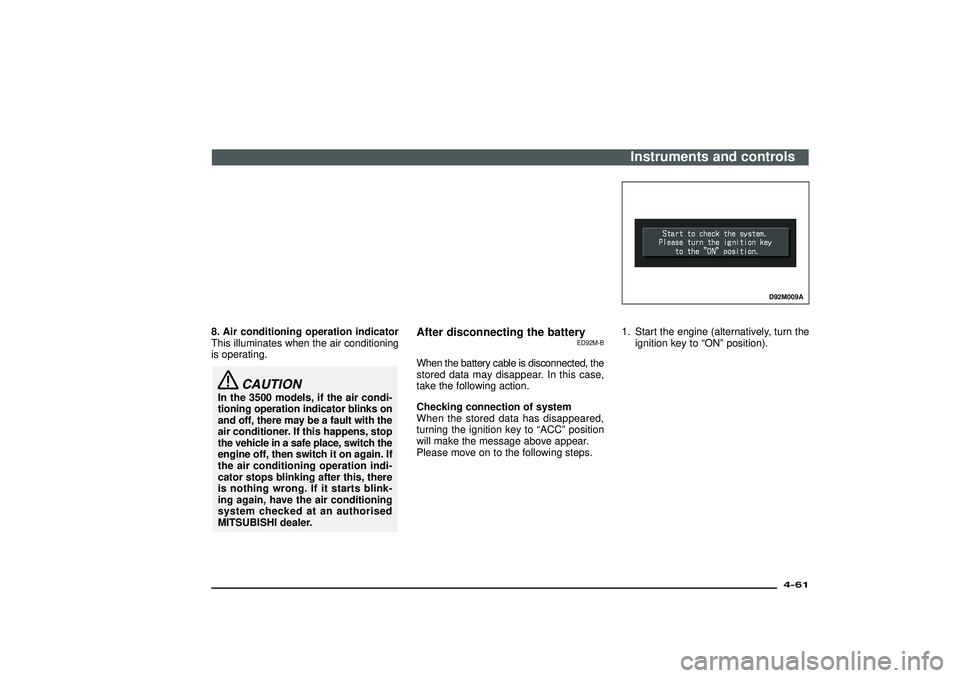
8. Air conditioning operation indicator
This illuminates when the air conditioning
is operating.
CAUTION
In the 3500 models, if the air condi-
tioning operation indicator blinks on
and off, there may be a fault with the
air conditioner. If this happens, stop
the vehicle in a safe place, switch the
engine off, then switch it on again. If
the air conditioning operation indi-
cator stops blinking after this, there
is nothing wrong. If it starts blink-
ing again, have the air conditioning
system checked at an authorised
MITSUBISHI dealer.
After disconnecting the battery
ED92M-B
When the battery cable is disconnected, the
stored data may disappear. In this case,
take the following action.
Checking connection of system
When the stored data has disappeared,
turning the ignition key to“ACC”position
will make the message above appear.
Please move on to the following steps.
D92M009A
1. Start the engine (alternatively, turn the
ignition key to“ON”position).Instruments and controls
4-61
Div:
Out put date:
Page 162 of 392

Filling the fuel tank
EC20DOI
WARNING
Gasoline is highly flammable and
explosive. You could be burned or
seriously injured when handling it.
When refueling your vehicle, always
turn the engine off and keep away
from flames, sparks, and smoking
materrials. Always handlle fuel in
well-ventilated outdoor areas.Fuel tank capacity3-door models : 71 litres
5-door models : 90 litres
C20A197A
LHD1. Before filling with fuel, stop the engine.
2. The fuel tank filler door can be opened
from inside the vehicle by using the fuel
tank filler door release lever located
below the instrument panel.
C20A198A
RHD
Starting and driving
5-4Div:
Out put date:
Page 163 of 392
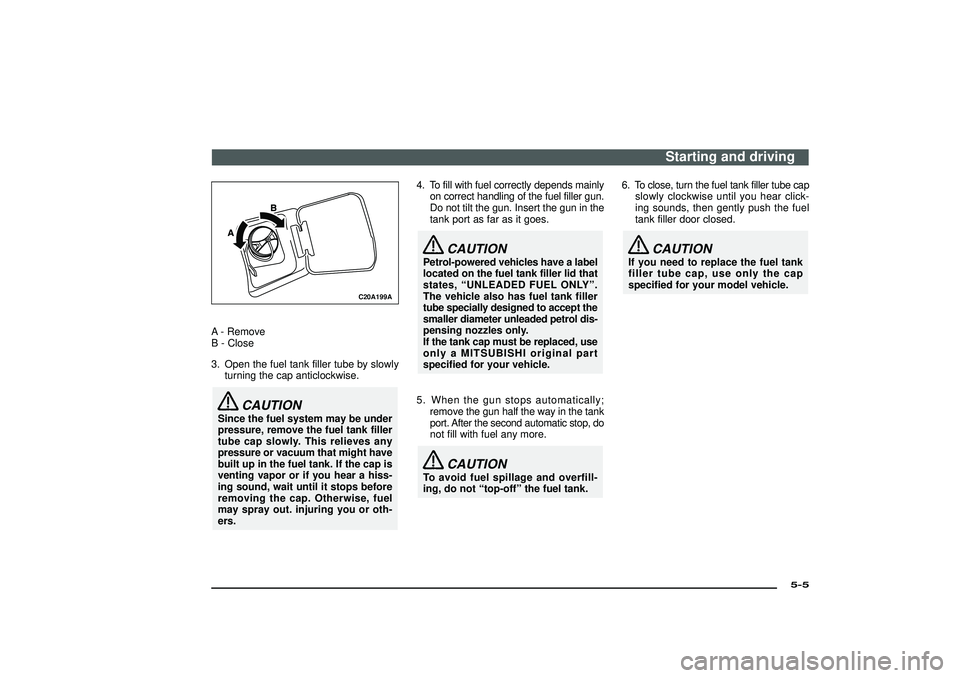
C20A199A
A - Remove
B - Close
3. Open the fuel tank filler tube by slowly
turning the cap anticlockwise.
CAUTION
Since the fuel system may be under
pressure, remove the fuel tank filler
tube cap slowly. This relieves any
pressure or vacuum that might have
built up in the fuel tank. If the cap is
venting vapor or if you hear a hiss-
ing sound, wait until it stops before
removing the cap. Otherwise, fuel
may spray out. injuring you or oth-
ers.4. To fill with fuel correctly depends mainly
on correct handling of the fuel filler gun.
Do not tilt the gun. Insert the gun in the
tank port as far as it goes.
CAUTION
Petrol-powered vehicles have a label
located on the fuel tank filler lid that
states,“UNLEADED FUEL ONLY”.
The vehicle also has fuel tank filler
tube specially designed to accept the
smaller diameter unleaded petrol dis-
pensing nozzles only.
If the tank cap must be replaced, use
only a MITSUBISHI original part
specified for your vehicle.
5. When the gun stops automatically;
remove the gun half the way in the tank
port. After the second automatic stop, do
not fill with fuel any more.
CAUTION
To avoid fuel spillage and overfill-
ing, do not“top-off”the fuel tank.6. To close, turn the fuel tank filler tube cap
slowly clockwise until you hear click-
ing sounds, then gently push the fuel
tank filler door closed.
CAUTION
If you need to replace the fuel tank
filler tube cap, use only the cap
specified for your model vehicle.
Starting and driving
5-5
Div:
Out put date:
Page 165 of 392
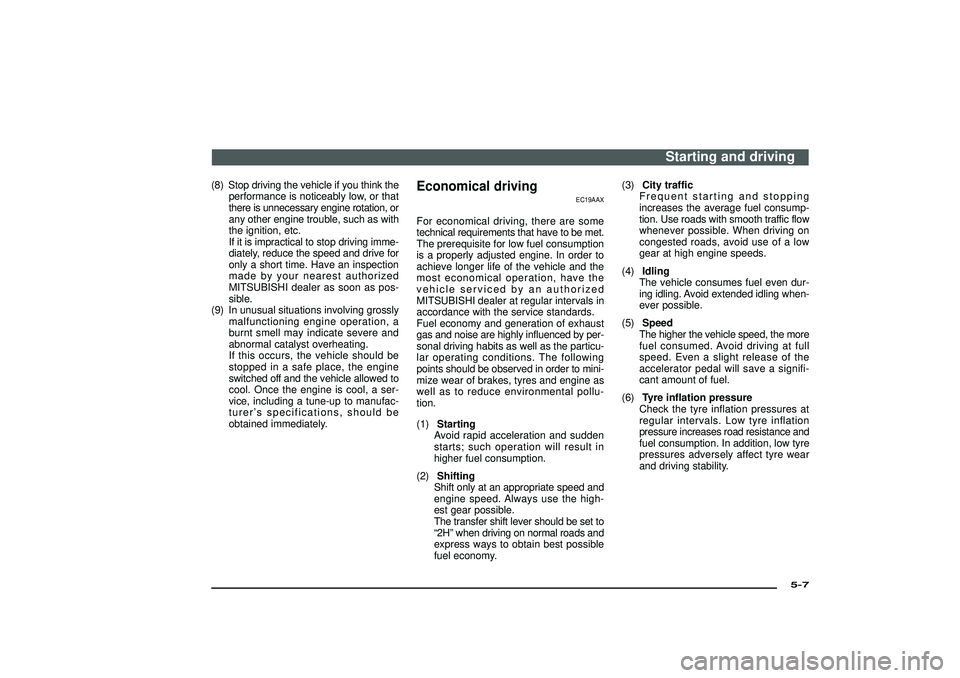
(8) Stop driving the vehicle if you think the
performance is noticeably low, or that
there is unnecessary engine rotation, or
any other engine trouble, such as with
the ignition, etc.
If it is impractical to stop driving imme-
diately, reduce the speed and drive for
only a short time. Have an inspection
made by your nearest authorized
MITSUBISHI dealer as soon as pos-
sible.
(9) In unusual situations involving grossly
malfunctioning engine operation, a
burnt smell may indicate severe and
abnormal catalyst overheating.
If this occurs, the vehicle should be
stopped in a safe place, the engine
switched off and the vehicle allowed to
cool. Once the engine is cool, a ser-
vice, including a tune-up to manufac-
turer’s specifications, should be
obtained immediately.
Economical driving
EC19AAX
For economical driving, there are some
technical requirements that have to be met.
The prerequisite for low fuel consumption
is a properly adjusted engine. In order to
achieve longer life of the vehicle and the
most economical operation, have the
vehicle serviced by an authorized
MITSUBISHI dealer at regular intervals in
accordance with the service standards.
Fuel economy and generation of exhaust
gas and noise are highly influenced by per-
sonal driving habits as well as the particu-
lar operating conditions. The following
points should be observed in order to mini-
mize wear of brakes, tyres and engine as
well as to reduce environmental pollu-
tion.
(1)Starting
Avoid rapid acceleration and sudden
starts; such operation will result in
higher fuel consumption.
(2)Shifting
Shift only at an appropriate speed and
engine speed. Always use the high-
est gear possible.
The transfer shift lever should be set to
“2H”when driving on normal roads and
express ways to obtain best possible
fuel economy.(3)City traffic
Frequent starting and stopping
increases the average fuel consump-
tion. Use roads with smooth traffic flow
whenever possible. When driving on
congested roads, avoid use of a low
gear at high engine speeds.
(4)Idling
The vehicle consumes fuel even dur-
ing idling. Avoid extended idling when-
ever possible.
(5)Speed
The higher the vehicle speed, the more
fuel consumed. Avoid driving at full
speed. Even a slight release of the
accelerator pedal will save a signifi-
cant amount of fuel.
(6)Tyre inflation pressure
Check the tyre inflation pressures at
regular intervals. Low tyre inflation
pressure increases road resistance and
fuel consumption. In addition, low tyre
pressures adversely affect tyre wear
and driving stability.
Starting and driving
5-7
Div:
Out put date:
Page 166 of 392
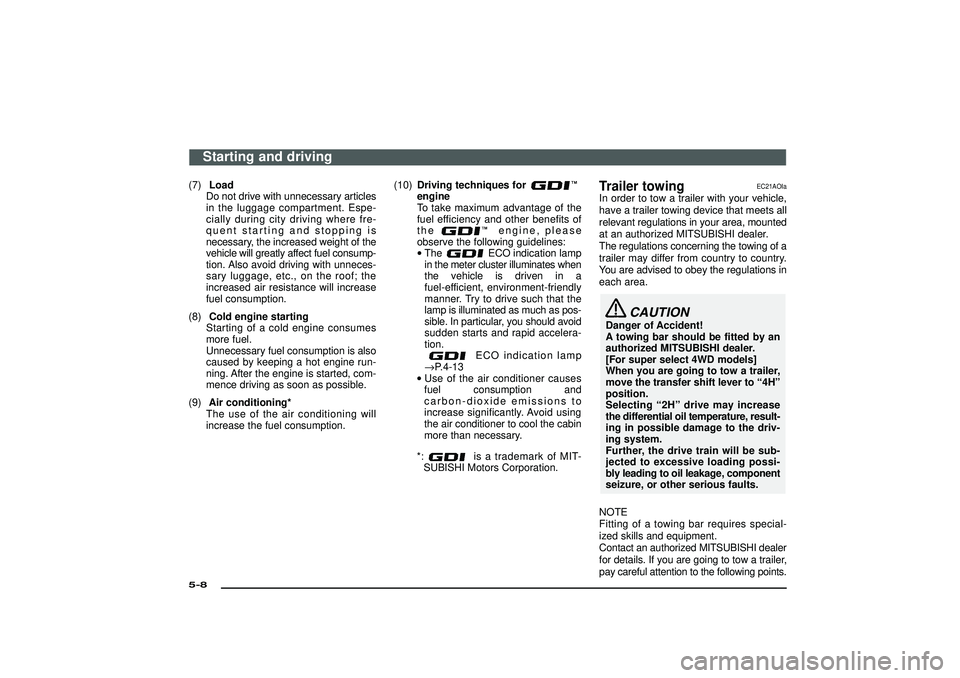
(7)Load
Do not drive with unnecessary articles
in the luggage compartment. Espe-
cially during city driving where fre-
quent starting and stopping is
necessary, the increased weight of the
vehicle will greatly affect fuel consump-
tion. Also avoid driving with unneces-
sary luggage, etc., on the roof; the
increased air resistance will increase
fuel consumption.
(8)Cold engine starting
Starting of a cold engine consumes
more fuel.
Unnecessary fuel consumption is also
caused by keeping a hot engine run-
ning. After the engine is started, com-
mence driving as soon as possible.
(9)Air conditioning*
The use of the air conditioning will
increase the fuel consumption.(10)Driving techniques for
engine
To take maximum advantage of the
fuel efficiency and other benefits of
the
engine, please
observe the following guidelines:
•TheECO indication lamp
in the meter cluster illuminates when
the vehicle is driven in a
fuel-efficient, environment-friendly
manner. Try to drive such that the
lamp is illuminated as much as pos-
sible. In particular, you should avoid
sudden starts and rapid accelera-
tion.
ECO indication lamp
→P.4-13
•Use of the air conditioner causes
fuel consumption and
carbon-dioxide emissions to
increase significantly. Avoid using
the air conditioner to cool the cabin
more than necessary.
*:is a trademark of MIT-
SUBISHI Motors Corporation.
Trailer towing
EC21AOIa
In order to tow a trailer with your vehicle,
have a trailer towing device that meets all
relevant regulations in your area, mounted
at an authorized MITSUBISHI dealer.
The regulations concerning the towing of a
trailer may differ from country to country.
You are advised to obey the regulations in
each area.
CAUTION
Danger of Accident!
A towing bar should be fitted by an
authorized MITSUBISHI dealer.
[For super select 4WD models]
When you are going to tow a trailer,
move the transfer shift lever to“4H”
position.
Selecting“2H”drive may increase
the differential oil temperature, result-
ing in possible damage to the driv-
ing system.
Further, the drive train will be sub-
jected to excessive loading possi-
bly leading to oil leakage, component
seizure, or other serious faults.
NOTE
Fitting of a towing bar requires special-
ized skills and equipment.
Contact an authorized MITSUBISHI dealer
for details. If you are going to tow a trailer,
pay careful attention to the following points.
Starting and driving
5-8Div:
Out put date:
Page 169 of 392
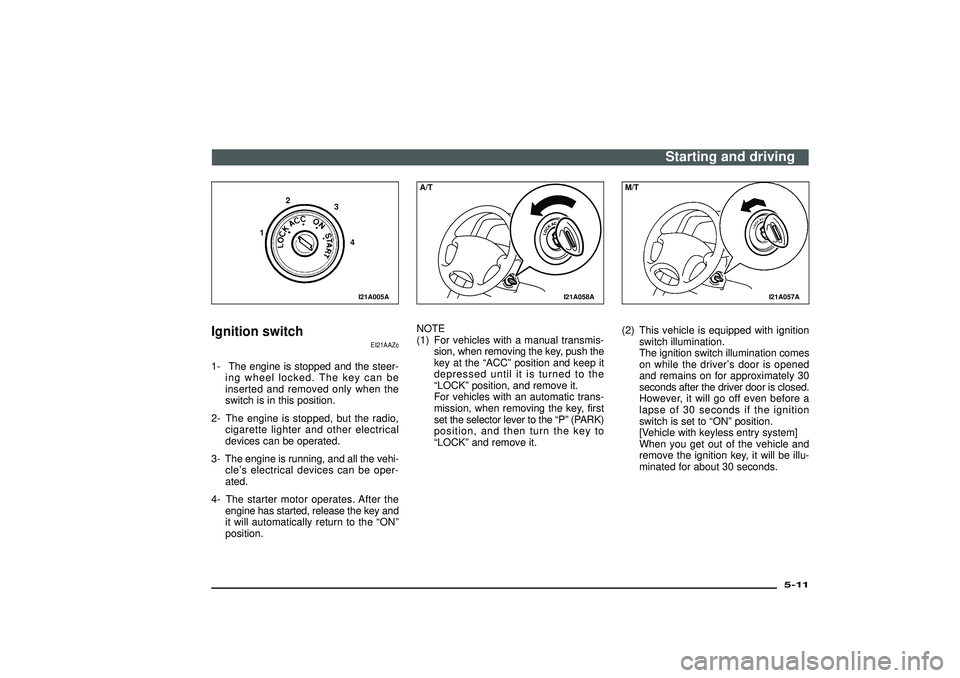
I21A005A
12
3
4
Ignition switch
EI21AAZc
1- The engine is stopped and the steer-
ing wheel locked. The key can be
inserted and removed only when the
switch is in this position.
2- The engine is stopped, but the radio,
cigarette lighter and other electrical
devices can be operated.
3- The engine is running, and all the vehi-
cle’s electrical devices can be oper-
ated.
4- The starter motor operates. After the
engine has started, release the key and
it will automatically return to the“ON”
position.
I21A058A
A/TNOTE
(1) For vehicles with a manual transmis-
sion, when removing the key, push the
key at the“ACC”position and keep it
depressed until it is turned to the
“LOCK”position, and remove it.
For vehicles with an automatic trans-
mission, when removing the key, first
set the selector lever to the“P”(PARK)
position, and then turn the key to
“LOCK”and remove it.
I21A057A
M/T(2) This vehicle is equipped with ignition
switch illumination.
The ignition switch illumination comes
on while the driver’s door is opened
and remains on for approximately 30
seconds after the driver door is closed.
However, it will go off even before a
lapse of 30 seconds if the ignition
switch is set to“ON”position.
[Vehicle with keyless entry system]
When you get out of the vehicle and
remove the ignition key, it will be illu-
minated for about 30 seconds.
Starting and driving
5-11
Div:
Out put date:
Page 170 of 392
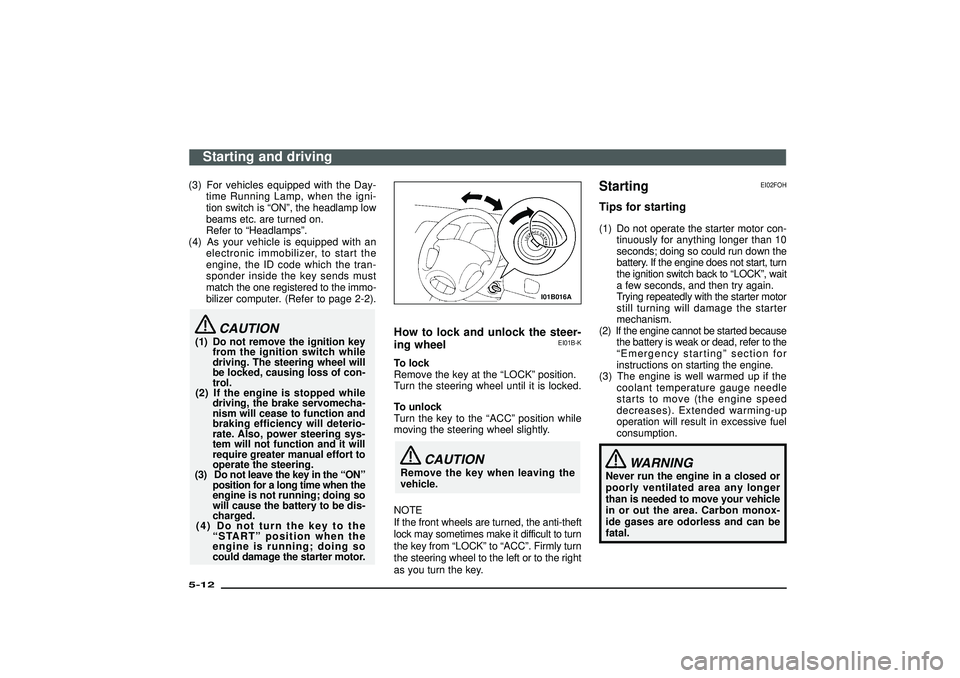
(3) For vehicles equipped with the Day-
time Running Lamp, when the igni-
tion switch is“ON”, the headlamp low
beams etc. are turned on.
Refer to“Headlamps”.
(4) As your vehicle is equipped with an
electronic immobilizer, to start the
engine, the ID code which the tran-
sponder inside the key sends must
match the one registered to the immo-
bilizer computer. (Refer to page 2-2).
CAUTION
(1) Do not remove the ignition key
from the ignition switch while
driving. The steering wheel will
be locked, causing loss of con-
trol.
(2) If the engine is stopped while
driving, the brake servomecha-
nism will cease to function and
braking efficiency will deterio-
rate. Also, power steering sys-
tem will not function and it will
require greater manual effort to
operate the steering.
(3) Do not leave the key in the“ON”
position for a long time when the
engine is not running; doing so
will cause the battery to be dis-
charged.
(4) Do not turn the key to the
“START”position when the
engine is running; doing so
could damage the starter motor.
I01B016A
How to lock and unlock the steer-
ing wheel
EI01B-K
To lock
Remove the key at the“LOCK”position.
Turn the steering wheel until it is locked.
To unlock
Turn the key to the“ACC”position while
moving the steering wheel slightly.
CAUTION
Remove the key when leaving the
vehicle.
NOTE
If the front wheels are turned, the anti-theft
lock may sometimes make it difficult to turn
the key from“LOCK”to“ACC”. Firmly turn
the steering wheel to the left or to the right
as you turn the key.
Starting
EI02FOH
Tips for starting(1) Do not operate the starter motor con-
tinuously for anything longer than 10
seconds; doing so could run down the
battery. If the engine does not start, turn
the ignition switch back to“LOCK”, wait
a few seconds, and then try again.
Trying repeatedly with the starter motor
still turning will damage the starter
mechanism.
(2) If the engine cannot be started because
the battery is weak or dead, refer to the
“Emergency starting”section for
instructions on starting the engine.
(3) The engine is well warmed up if the
coolant temperature gauge needle
starts to move (the engine speed
decreases). Extended warming-up
operation will result in excessive fuel
consumption.
WARNING
Never run the engine in a closed or
poorly ventilated area any longer
than is needed to move your vehicle
in or out the area. Carbon monox-
ide gases are odorless and can be
fatal.
Starting and driving
5-12Div:
Out put date:
Page 171 of 392
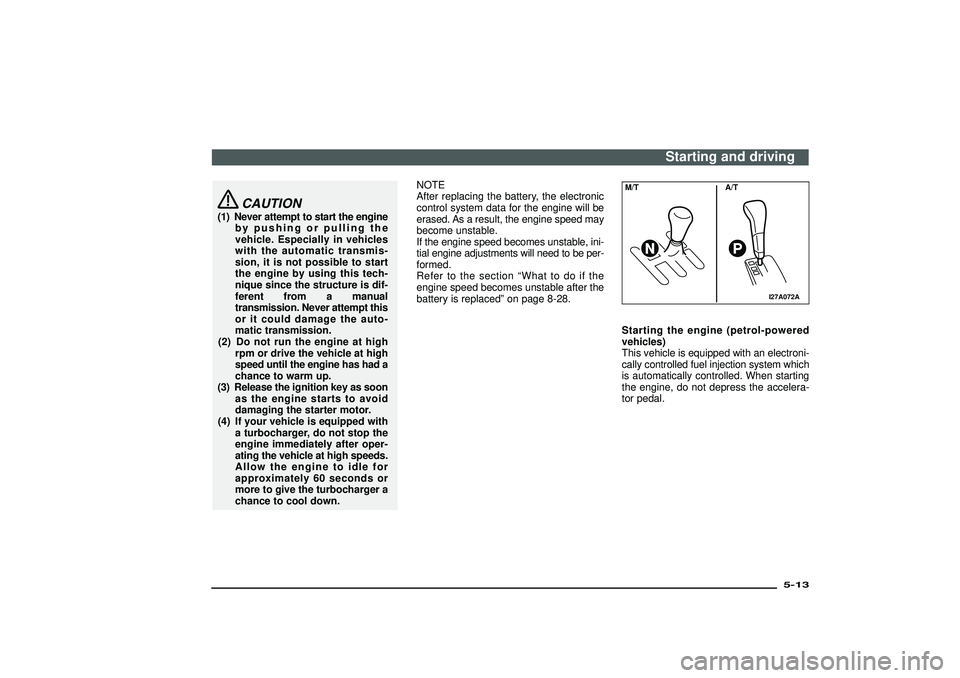
CAUTION
(1) Never attempt to start the engine
by pushing or pulling the
vehicle. Especially in vehicles
with the automatic transmis-
sion, it is not possible to start
the engine by using this tech-
nique since the structure is dif-
ferent from a manual
transmission. Never attempt this
or it could damage the auto-
matic transmission.
(2) Do not run the engine at high
rpm or drive the vehicle at high
speed until the engine has had a
chance to warm up.
(3) Release the ignition key as soon
as the engine starts to avoid
damaging the starter motor.
(4) If your vehicle is equipped with
a turbocharger, do not stop the
engine immediately after oper-
ating the vehicle at high speeds.
Allow the engine to idle for
approximately 60 seconds or
more to give the turbocharger a
chance to cool down.NOTE
After replacing the battery, the electronic
control system data for the engine will be
erased. As a result, the engine speed may
become unstable.
If the engine speed becomes unstable, ini-
tial engine adjustments will need to be per-
formed.
Refer to the section“What to do if the
engine speed becomes unstable after the
battery is replaced”on page 8-28.
I27A072A
M/T A/TStarting the engine (petrol-powered
vehicles)
This vehicle is equipped with an electroni-
cally controlled fuel injection system which
is automatically controlled. When starting
the engine, do not depress the accelera-
tor pedal.
Starting and driving
5-13
Div:
Out put date: